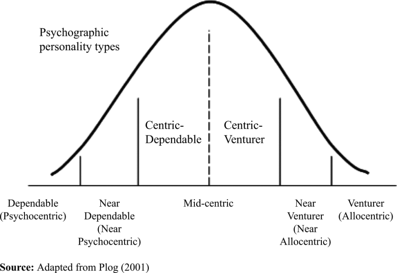Overtourism is now a term that is frequently used to describe the negative impacts of excessive tourism on a destination. The impacts of overtourism are numerous and even if the term is quite new, we can find traces of this concept already among scholars in the beginning of mass tourism. Plog, for example, related the evolution of the number of tourists in a destination to the type of tourists visiting that same destination.
Tourists are divided into 3 categories:
- Allocentric tourists with a preference for non-touristy areas and novel destinations
- Midcentric tourists, being less adventurous and preferring quasi mainstream attractions
- Psychocentric tourists, seeking familiarity and preferring tour packages.
What the figure below below illustrates is that the more touristic the destination is, the more psychocentric the tourists are. This modification in tourists’ segments has a direct impact on the destination.
Typically, psychocentric travelers can cause cultural change, because of their demand for standardized infrastructures and services, economic leakage because of their use of services provided by foreigners (e.g. tour packages) and loss of clients, because allocentric and mid-centric tourists will leave for other destinations.

Figure 1: Plog’s tourist model of destination preferences
Cambodia, and more specifically, Angkor Wat’s nearby city Siem Reap, is a great example of this phenomenon.
- In 1992, the archaeological site of Angkor is added to the UNESCO World Heritage list. With the political stabilization in the country, tourism explodes.
- While only 118,183 international tourists visited the country in 1993, Cambodia hosted 6,201,077 visitors in 2018.
- To host the booming tourism, an airport is built in Siem Reap in 2006.
- In 2017, Angkor Wat is chosen as the World’s Top Tourism Landmark by TripAdvisor.
- In 2018, 2,590,815 foreign visitors arrived in Siem Reap, representing 38.3% of the country’s international tourism.
Tourism growth has impacted tourism segments throughout the years.
In the early 2000s, the main visitors to Cambodia were westerners (USA, France, UK). Now China, Vietnam, Laos, Thailand and Korea account for 67.1% of the tourism industry, with 32.6% for the Chinese market, which represents an increase of 67.2% between 2017 and 2018.
In 2011, Chheang studied tourists’ motivations to visit Angkor Wat. The study showed that the main interests to visit the region were learning new things, local culture and history and experience the local atmosphere. These interests, which could be attributed to allocentric travelers, were stronger among non-Asian tourists than among Asian tourists. The increase of Asian tourists in Angkor Wat could lead to the replacement of allocentric travelers by psychocentric travelers.
Cambodia and Angkor Wat are becoming increasingly attractive to Chinese tourists.
Cambodia’s Deputy Prime Minister declared wanting to target 20 million Chinese tourists in 2020 and he uses all the necessary means to achieve his objective.
There are currently 31 direct flights per week between Siem Reap and China, Chinese investments are encouraged by the government (e.g. a Chinese company obtained a concession to build a new airport near the Angkor Wat area, the construction is expected to be completed by 2022) and the government created an accreditation for “Chinese-friendly” tour operators, based on the criteria of the Ministry of Tourism’s China Ready Center.
But what are the impacts of these modifications of tourism segments?
First, Chinese tourists tend to frequent Chinese-owned businesses and usually book organized tours with them. These preferences, typical of psychocentric travelers, increase the economic leakage, already very high in Cambodia.
In 2008, although only 15% of the touristic infrastructure in Siem Reap was owned by foreigners, 28.3% of the benefits left the country. Moreover, Chinese tourists usually spend only a few days in the destination, therefore, they spend little. In 2018, the average length of stay was seven days, one day less than in 1995. Chinese tourists, and more generally, the Asian tourism market is booming, replacing slowly the decreasing old markets, like westerners.
On the other hand, with the great relations between Cambodia and China, many Chinese companies are investing in the development of the country, creating jobs, building bridges, roads and solar power plants. Moreover, Chinese tourists are also interested in nature, this is the second main attraction for them in Cambodia, after culture. To meet their demand for nature, the Cambodian government promotes and develops eco-tourism. For example, Kulen Revealed, has provided, since 2018, community-based ecotours in Kulen Mountain, near Siem Reap.
A Chinese-dominated tourism economy generates diverse impacts in a destination such as Siem Reap.
The tourism strategy needs to be managed carefully, focusing on the right segments to avoid irreversible impacts. In Thailand, Chinese tourists are also a major segment, representing 8.7 million visitors in 2016. The government had to take measures, like banning cheap tours bringing no benefits to the country or discouraging big tour groups.
These measures, combined with cultural differences between the level of education between tourists and the local population, can limit the conflicts and avoid tourism rejection seen elsewhere (e.g., Venice, Barcelona, etc.). Moreover, the new Chinese generation differs from its predecessors. They are mostly independent travelers, seeking unique experiences.
With 149.2 million Chinese tourists in the world in 2018, destinations need to understand how they can tap into this growing market, without compromising the interests of other markets.
References:
Aldama, Z. (2017). How Chinese tourists are changing the world. Post Magazine. Retrieved from: https://www.scmp.com/magazines/post-magazine/long-reads/article/2113116/how-chinese-tourists-are-changing-world
CAPA. (2018). Siem Reap new international airport. CAPA. Retrieved from: https://centreforaviation.com/data/profiles/newairports/siem-reap-new-international-airport
Chheang, V. (2011). Angkor heritage tourism and tourist perceptions. Tourismos: an international multidisciplinary journal of tourism, 6(2), 213-240. Retrieved from: http://www.chios.aegean.gr/tourism/VOLUME_6_No2_art13.pdf
Construction & Property. (2019). Cambodia to see massive infrastructure investment from Chinese firms. Construction & Property. Retrieved from: https://www.construction-property.com/read-news-1612/
Connor, L. (2019). ‘They only go to Chinese shops’: why Cambodia’s influx of mainland tourists is causing tensions. This week in Asia. Retrieved from: https://www.scmp.com/week-asia/society/article/2180257/they-only-go-chinese-shops-why-cambodias-influx-mainland-tourists
Neth, B. (2011). Angkor as World Heritage Site and the Development of Tourism: A Study of Tourist Revenue in the Accommodation Sector in Siem Reap-Angkor. In: World Heritage Angkor and Beyond: Circumstances and Implications of UNESCO Listings in Cambodia (pp.147-176). Retrieved from: http://books.openedition.org/gup/313
Peltier, D. (2018). Independent Chinese travellers close gap with tour groups. Skift. Retrieved from: https://skift.com/2018/10/29/independent-chinese-travelers-close-gap-with-tour-groups/
Plog, S. C. (2001). Why destination areas rise and fall in popularity: An update of a Cornell Quarterly Classic. Cornell Hotel and Restaurant Administration Quarterly, 42(3), 13-24
Southern, N. P. (2017). Cambodia’s tourism industry: A Kingdom for more tourists. Globe. Retrieved from: https://southeastasiaglobe.com/cambodia-future-tourism/
Sullivan, N. (2015). Siem Reap warned Chinese tourists pose challenge and opportunity. The Phnom Penh Post. Retrieved from: https://www.phnompenhpost.com/siem-reap-insider/siem-reap-warned-chinese-tourist-post-challenge-and-opportunity
Tourism Statistics Department, Ministry of tourism [MOT]. (2006). Cambodia tourist statistical report 2006. Ministry of tourism. Retrieved from: https://www.catacambodia.com/Cambodia%20Tourism%20Statistics%20-%202006.pdf
Tourism Statistics Department, Ministry of tourism [MOT]. (2018). Tourism Statistics Report - Year 2018. Ministry of tourism. Retrieved from: https://amchamcambodia.net/wp-content/uploads/2019/04/Year_2018.pdf
Vannak, C. & Manet, S. (2016). Cambodia-China tourism pact. Khmer Times. Retrieved from: https://www.khmertimeskh.com/7913/cambodia-china-tourism-pact/
Xinhua (2019). Chinese tourists make nearly 150 mln outbound trips in 2018. China Daily. Retrieved from: http://www.chinadaily.com.cn/a/201902/14/WS5c64e2fca3106c65c34e9528.html
Assistant professor at EHL Hospitality Business School





